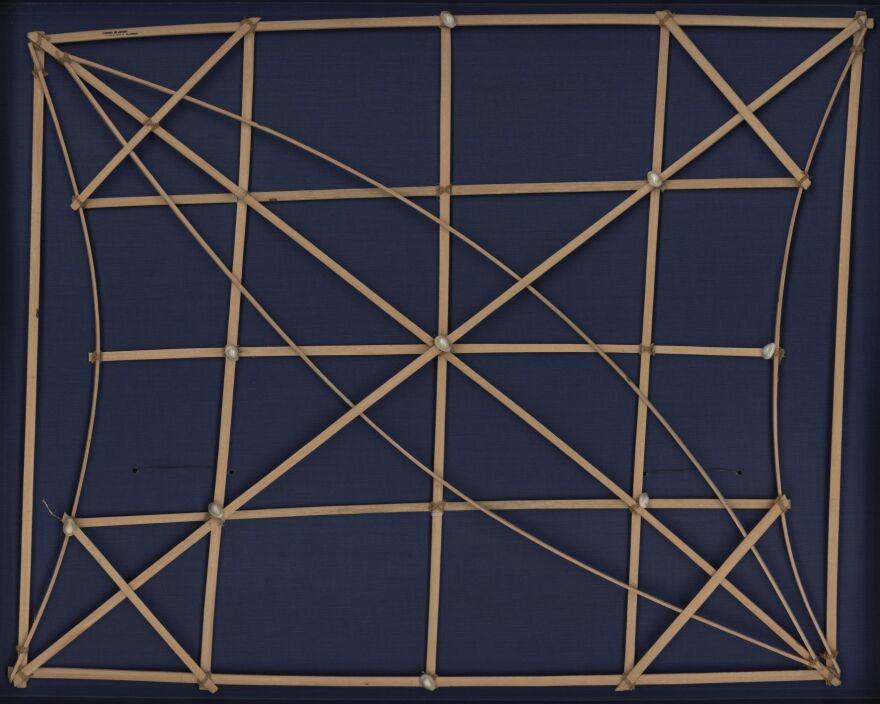"I'm sitting next to a swimming pool and somebody dives in," says the great physicist Richard Feynman in a conversation recorded in 1983. Other people jump in as well.

Could a really clever person, Feynman asks, just by looking at the waves on the pool's surface, imagine those waves rippling backwards and "figure out who jumped in where and when?" In other words, can somebody read a wave's history?
As Feynman ponders his own question, he falls into a wonderful, deeply felt meditation on waves (hang on, you can it at the bottom of this post), and I thought, wait! I know about people who could 'read' waves — who could wind them backwards. They lived in the middle of the Pacific Ocean, on islands barely 3 or 4 feet above sea level, and performed miracles of navigation.
I'm talking about Micronesian canoeists. They'd matter-of-factly jump into canoes and travel a hundred or 200 miles across empty ocean to get to another dot of an island, barely visible, and over and over, they'd find their target. They had stars to navigate by, but only some of the time. Often it was cloudy, or dark. So how'd they do it?

In his book, The Wave Watcher's Companion, Gavin Pretor-Pinney says those Micronesian sailors could "feel" the waves telling them where there was land. The waves pointed back to land that was 30, even 40 miles away.
The navigators wouldn't stare at the sea. Instead, they'd lie down on the boat's bottom and, resting against the wood, they'd tell their companions, "the land is behind us" or " I can feel the land up ahead."
But how did they know? Pretor-Pinney tells us to think of an island in the ocean. Think of the current, or the wind, pushing the water in a particular direction. If there's an island in the current's path, the waves will be deflected, and there will be a zone of calm, in the island's wake.

That "shadow of calm," Pretor-Pinney writes, can be detected. It will travel with the rest of the ocean and carry its calmness farther and farther offshore. That absence of ocean swells tells the navigator, "there's an island near here."
In 1862, a missionary watched Micronesians learning to read the presence and absence of swells. He reported seeing one of the crew apparently "listening" to the currents below. Pretor-Pinney thinks the navigator wasn't really listening, but more likely was noticing, very carefully, which way the boat was rocking. "If the stern lifted before the bow, the swell was coming from behind," he writes. "If port lifted before starboard, it was coming from the left."

According to David Lewis, in his book We Navigators: The Ancient Art of Landfinding in the Pacific, this skill was taught by parents to children with the use of tool.
This is what it looked like. It's a chart (made of sticks) called a mattang. David Lewis writes:
Made from strips of coconut-palm fronds tied together into a lattice, these showed how the swells were reflected off the islands and how they changed direction as they refracted and diffracted around them.
Small shells attached to the stick charts represented the land. Since the swells tend to come from consistent directions, navigators could learn to judge the direction of an island from as far as forty miles away by the way it affected the wave paths.
So yes, 200 years ago (and probably long before that) people matter-of-factly listened to waves and rolled them backwards to locate land.
Could you do that in a crowded swimming pool? It would be hard, says Richard Feynman, in this rich monologue, recorded in 1983 by the BBC. We live, he says, in "a tremendous mess of waves." There are waves in our pools, waves in the sea, sound waves, light waves, radio waves, magnetic waves bopping us, moving through us all the time. We can detect some of them, but not all. So yes, Micronesian navigators were masterful at reading waves, but as you'll hear in this wonderful little monologue — so, dear reader, are you.
Maybe you didn't realize how good you are, but let Professor Feynman flatter you for five minutes. It's nice to be complimented by a genius.
Thanks to Lawrence Weschler for showing me Feynman's video. It is currently part of a fascinating exhibit at the National Museum of Mathematic, in New York, featuring the art work of .
Copyright 2020 NPR. To see more, visit https://www.npr.org. 9(MDAwMTM1NDgzMDEyMzg2MDcwMzJjODJiYQ004))


